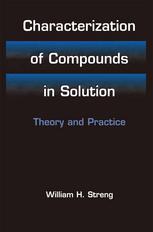

Most ebook files are in PDF format, so you can easily read them using various software such as Foxit Reader or directly on the Google Chrome browser.
Some ebook files are released by publishers in other formats such as .awz, .mobi, .epub, .fb2, etc. You may need to install specific software to read these formats on mobile/PC, such as Calibre.
Please read the tutorial at this link: https://ebookbell.com/faq
We offer FREE conversion to the popular formats you request; however, this may take some time. Therefore, right after payment, please email us, and we will try to provide the service as quickly as possible.
For some exceptional file formats or broken links (if any), please refrain from opening any disputes. Instead, email us first, and we will try to assist within a maximum of 6 hours.
EbookBell Team

5.0
40 reviewsScientists from many disciplines require making observations which are dependent upon the behavior of compounds in solution. This ranges from areas in geography, such as oceanography, to areas in chemistry, such as chromatography, to areas in biology, such as pharmacology. Historically, information would be obtained by observing a response for a given set of conditions and then the conditions would be changed and a new response obtained. In this approach there would be little effort made to actually understand how a compound was behaving in solution but rather just the response was noted. Understanding the behavior of compounds in solution is critical to understanding their behavior in biological systems. This has become increasingly important during the last twenty years as an understanding of the biochemistry related to human illness has become better understood. The development of the pharmaceutical industry and the need to rapidly screen large numbers of compounds has made scientists in the area of drug development aware that the pharmacological activity of compounds can be predicted by knowing their solution physical chemical properties. This is not to say that a specific drug-active site interaction can be predicted but rather a prediction can be made whether or not a compound will be absorbed, transported, or distributed within a physiological system in such a way that an interaction can occur.